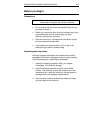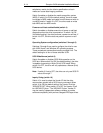
A-14 Scorpion 240 Autoloader Installation Manual
satisfactory results, but the inferior specifications of such
media can cause data-integrity problems.
Switch 3 enables or disables the media-recognition system
(MRS). If switch 3 is ON (the default setting), the drive reads
and writes to MRS media and reads from but does not write to
non-MRS media. If switch 3 is OFF, the drive reads or writes
both MRS and non-MRS media.
Power-on self-test enable/disable (switch 4)
Switch 4 enables or disables execution of power-on self-test
diagnostics when the drive is powered on. If switch 4 is ON
(the default setting), the drive performs a power-on self test. If
switch 4 is OFF, the drive does not perform a power-on self
test.
Operating System configuration (switches 5 through 8)
Switches 5 through 8 are used to configure the drive for use
with UNIX, Novell, and Windows NT operating systems.
These procedures are described starting on page A-40. The
default setting for all four of these switches is ON.
SCSI Wide/Narrow (switch 9)
Switch 9 enables or disables SCSI Wide operation on the
SCSI bus. When switch 9 is ON (the default setting), the drive
is capable of operating in Wide (16-bit) SCSI mode. When
switch 9 is OFF, the drive will only operate as a Narrow (8-bit)
SCSI device.
Note: If switch 9 if set to OFF, the drive can only use SCSI ID
values 0 through 7.
Inquiry String (switch 10)
Switch 10 is used to select the Vendor ID that the drive
returns when queried with a SCSI Inquiry command. When
switch 10 is ON (the default setting), the Vendor ID will be
“SEAGATE DAT.” When switch 10 is OFF the Vendor ID will
be “ARCHIVE Python.” The “ARCHIVE Python” Vendor ID
may be used by independent software vendors to provide
software compatibility with previous Seagate DDS tape drives.


















